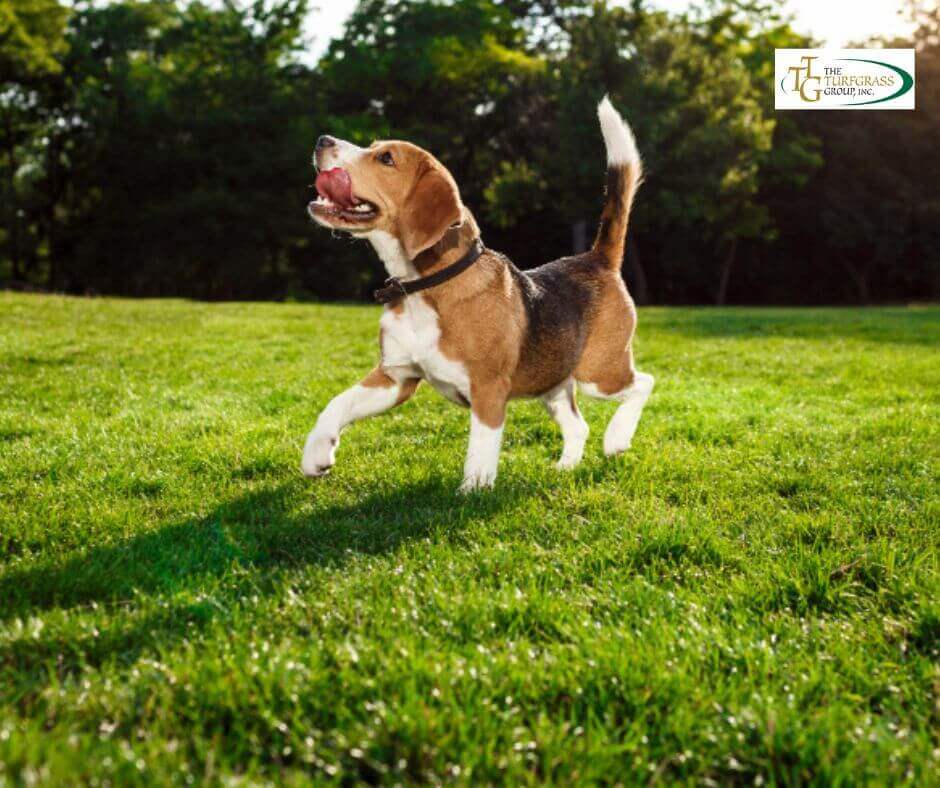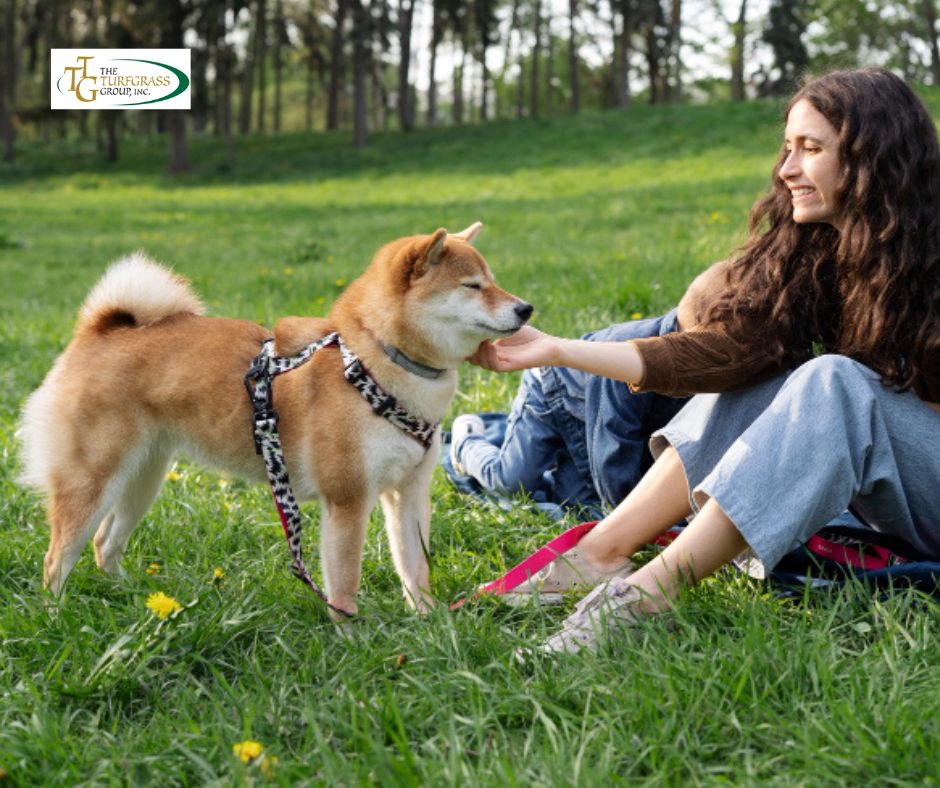
Pets bring immense joy and companionship to our lives, becoming cherished members of the family.
However, maintaining a beautiful lawn while keeping our furry friends safe can sometimes present challenges.
From potential toxicities in fertilizers to the risk of pests and parasites, there are several factors to consider when ensuring a harmonious coexistence between pets and our outdoor spaces.
In this article, we’ll explore practical tips to create a safe and healthy environment for both your pets and your lawn.
Understanding Potential Hazards
Before diving into the tips, it’s crucial to understand the potential hazards that may exist within your lawn environment. These hazards can include:
Chemicals in fertilizers, pesticides, and herbicides: Many common lawn care products contain chemicals that can be harmful to pets if ingested or absorbed through the skin.
Sharp objects: Items such as garden tools, broken branches, or rocks can pose a risk of injury to pets if left scattered across the lawn.
Toxic plants: Certain plants commonly found in gardens and yards can be toxic to pets if ingested, causing symptoms ranging from mild gastrointestinal upset to severe toxicity.
Pests and parasites: Fleas, ticks, mosquitoes, and other pests can thrive in outdoor environments, posing health risks to both pets and humans.
Tips for a Safe and Healthy Coexistence
Choose pet-safe lawn care products: Opt for pet-friendly fertilizers, pesticides, and herbicides that are labeled as safe for use around pets.
Look for products made with natural ingredients or those that have undergone rigorous testing to ensure they pose minimal risk to animals.
Read and follow product labels: Carefully read and follow the instructions on lawn care product labels, including any precautions or safety measures specific to pets.
Avoid using products that recommend keeping pets off treated areas for an extended period.
Keep pets indoors during lawn maintenance: When applying lawn care products or performing maintenance tasks such as mowing, trimming, or pruning, it’s best to keep pets indoors or in a designated safe area away from the treated areas until the products have dried or settled.
Create pet-friendly zones: Designate specific areas of your lawn as pet-friendly zones where your furry companions can roam freely without coming into contact with potentially harmful substances.
Consider using natural barriers such as fences or hedges to separate these areas from treated sections of the lawn.
Regularly inspect the lawn for hazards: Conduct routine inspections of your lawn to identify and remove any potential hazards such as sharp objects, toxic plants, or signs of pest infestation.
Promptly address any issues to ensure a safe environment for your pets to enjoy.
Provide plenty of shade and water: Ensure your lawn has shaded areas where pets can seek refuge from the sun, especially during hot weather.
Additionally, always provide access to clean, fresh water to prevent dehydration and overheating.
Choose pet-friendly landscaping: When designing or updating your lawn and garden, opt for pet-friendly landscaping options such as non-toxic plants and mulches.
Research pet-safe plant varieties and avoid those known to be harmful to animals if ingested.

Implement pest control measures: Take proactive steps to control pests and parasites in your lawn by using pet-safe methods such as flea and tick prevention treatments recommended by your veterinarian.
Regularly groom and inspect your pets for signs of pests, and consult with a professional exterminator if necessary.
Train pets to respect boundaries: Teach your pets to respect boundaries and avoid certain areas of the lawn where they may be at risk of encountering hazards.
Consistent training and positive reinforcement can help reinforce desired behaviors and keep pets safe.
Supervise outdoor time: Whenever your pets are outdoors, supervise their activities to ensure they remain safe and avoid potential hazards.
Keep an eye on them while they explore the lawn, and intervene if necessary to prevent accidents or ingestion of harmful substances.
Incorporate pet-friendly amenities: Enhance your lawn with features specifically designed to cater to your pets’ needs.
Consider adding a sandbox for digging, agility equipment for exercise, or a designated potty area to minimize damage to the grass and make cleanup easier.
Practice responsible waste management: Be diligent about picking up after your pets to maintain a clean and hygienic lawn environment.
Use biodegradable bags to dispose of pet waste properly and prevent contamination of soil and water sources.
Maintain a regular grooming routine: Regular grooming not only keeps your pets looking their best but also helps prevent issues such as matting, hot spots, and skin infections.
Brushing your pets regularly removes loose fur, dirt, and debris, reducing the amount of allergens and potential contaminants they bring into the house from the lawn.
Consider alternative lawn options: If maintaining a traditional grass lawn proves challenging or impractical due to your pets’ needs or environmental factors, explore alternative landscaping options such as artificial turf, drought-tolerant ground covers, or hardscaping features.
These alternatives can offer a low-maintenance, pet-friendly solution that enhances the aesthetics of your outdoor space.
Educate yourself and others: Stay informed about potential hazards and best practices for pet and lawn care, and share this knowledge with fellow pet owners and community members.
By raising awareness and promoting responsible pet ownership, you can help create a safer and healthier environment for pets and humans alike.
Conclusion
By following these tips, you can create a safe and healthy outdoor environment for your pets while maintaining a beautiful lawn.
From choosing pet-safe lawn care products to implementing pest control measures and providing adequate shade and water, there are numerous ways to ensure a harmonious coexistence between your furry companions and your outdoor space.
With proper care and attention, you can enjoy the benefits of a lush, inviting lawn without compromising the well-being of your beloved pets.
FAQs
What are the common hazards for pets in outdoor spaces like lawns?
Common hazards include chemicals in fertilizers, pesticides, and herbicides, sharp objects such as garden tools, toxic plants, and pests like fleas, ticks, and mosquitoes.
How can I ensure the lawn care products I use are safe for my pets?
Choose pet-safe lawn care products labeled as safe for use around pets. Look for products made with natural ingredients or those rigorously tested for minimal risk to animals.
Is it safe for pets to be on the lawn after using lawn care products?
It’s best to keep pets indoors or in a designated safe area away from treated areas until products have dried or settled, following product label instructions.
How can I create a pet-friendly zone in my lawn?
Designate specific areas where pets can roam freely without encountering harmful substances. Use natural barriers like fences or hedges to separate these areas from treated sections.
What steps can I take to control pests and parasites in my lawn?
Implement pet-safe pest control methods like flea and tick prevention treatments recommended by your veterinarian. Regularly groom and inspect pets for signs of pests, and consult a professional exterminator if needed.
How can I train my pets to stay safe in the lawn?
Teach pets to respect boundaries and avoid hazardous areas through consistent training and positive reinforcement. Supervise their outdoor activities and intervene if necessary to prevent accidents.
What are some pet-friendly amenities I can incorporate into my lawn?
Consider adding features like a sandbox for digging, agility equipment for exercise, or a designated potty area to minimize grass damage and facilitate cleanup.
How should I dispose of pet waste properly?
Be diligent about picking up after pets using biodegradable bags to prevent soil and water contamination. Proper waste management maintains a clean and hygienic lawn environment.
What grooming routine should I follow for my pets?
Regular grooming keeps pets looking their best and prevents issues like matting and skin infections. Brush pets regularly to remove loose fur, dirt, and debris.
What are some alternative lawn options if traditional grass maintenance is challenging?
Explore alternatives like artificial turf, drought-tolerant ground covers, or hardscaping features for a low-maintenance, pet-friendly solution that enhances outdoor aesthetics.
How can I identify toxic plants that may be harmful to my pets?
Research common toxic plants in your region and learn to identify them. Keep a list of these plants and regularly inspect your lawn and garden to ensure they are not present.
What are some signs that my pet may have ingested something harmful from the lawn?
Watch for symptoms such as vomiting, diarrhea, lethargy, difficulty breathing, or seizures. If you suspect your pet has ingested something toxic, contact your veterinarian immediately.
Are there any lawn maintenance tasks that pose specific risks to pets?
Tasks like mowing, trimming, and pruning can pose risks if pets come into contact with equipment or freshly cut vegetation. Keep pets indoors or in a safe area during these activities to prevent accidents.
How can I prevent my pets from digging up the lawn?
Provide designated digging areas or redirect their behavior with toys and activities. Ensure they’re getting enough exercise and mental stimulation to discourage destructive behavior.
Is there a safe way to deter pests without harming my pets or the environment?
Consider natural pest deterrents such as planting pest-repelling plants like marigolds or using diatomaceous earth. Consult with a professional to find safe and effective pest control methods.